Navigate the ancient value of a biblical talent of gold and discover its astonishing worth in today's economy.

How Much Is a Talent of Gold in the Bible
Have you ever wondered what a talent of gold from the Bible would be worth today? You're not alone in your curiosity.
A talent was a unit of weight used in ancient times, but translating its value into today's dollars requires understanding its historical context and economic implications. By exploring the biblical significance, historical weight measures, and the modern equivalent of a talent of gold, you'll uncover insights into ancient wealth and its impact on today's financial systems.
This journey into the past not only illuminates the economic conditions of ancient civilizations but also offers a fascinating perspective on the value and perception of wealth through the ages. Let's explore this intriguing topic together, and you might find the comparisons to modern wealth both enlightening and surprising.
Key Takeaways
- A biblical talent of gold varied in weight, approximately between 20 to 40 kilograms, depending on the region and period.
- The monetary value of a talent in today's currency is hard to pinpoint due to historical weight standards and gold purity variations.
- Talents played a crucial role in ancient economies, significantly impacting trade expansion and wealth distribution among societies.
- In the Bible, a talent of gold symbolizes not just material wealth but also divine favor and God-given gifts.
Defining a Biblical Talent
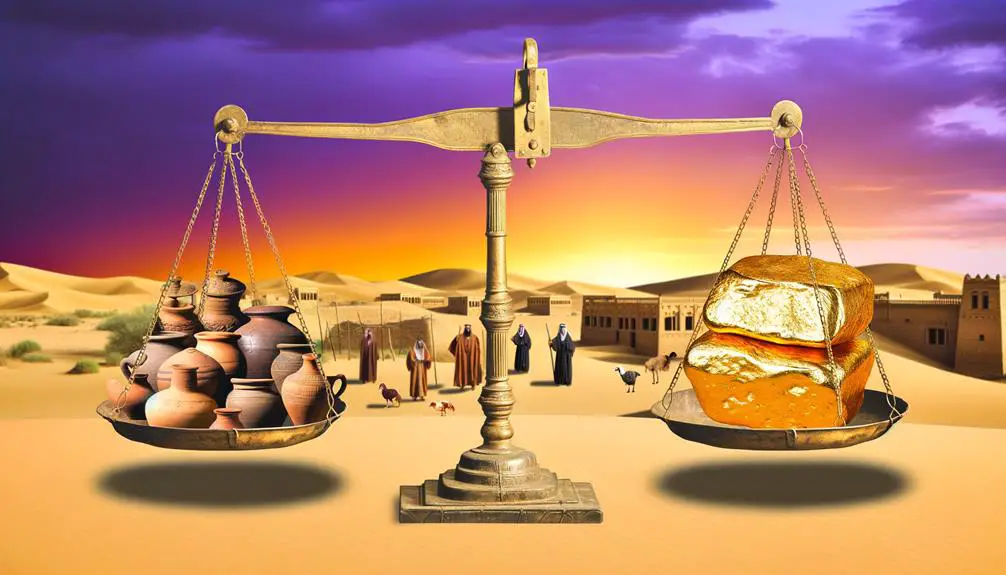
To accurately understand references to wealth in ancient texts, one must first grasp what a 'talent' of gold meant in the biblical context. The term 'talent' originates from ancient Mesopotamia and was adopted by the Greeks, Romans, and Hebrews, each with their variations. It's essential to recognize that a talent wasn't merely a unit of weight but also a significant monetary value. Its measurement origins are deeply rooted in the trade and economic systems of these ancient civilizations, serving as a pivotal benchmark for large-scale transactions and wealth assessment.
Talent variations across different cultures and periods make it challenging to pinpoint an exact weight. However, in the biblical context, scholars generally agree that a talent referred to a considerable amount of weight, often used to measure precious metals like gold and silver. The Hebrew talent, specifically mentioned in the Old Testament, varied in weight but is estimated to have been around 20 to 40 kilograms (44 to 88 pounds), depending on the historical period and region. This variation underscores the need for a nuanced understanding when interpreting ancient texts, as the value and weight associated with a talent could significantly impact the interpretation of a passage.
Historical Weight Measures
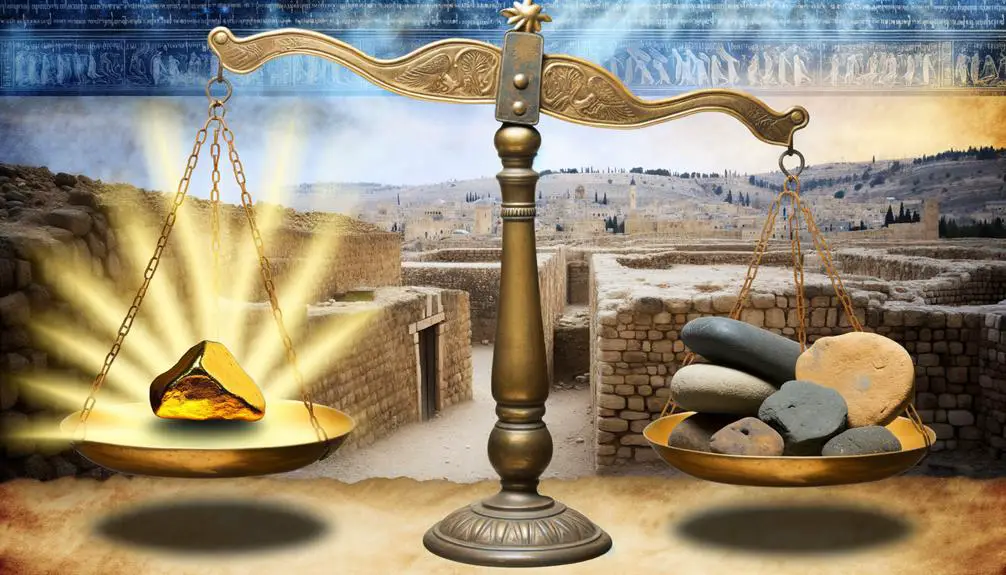
Delving into historical weight measures reveals a complex tapestry of units and standards that evolved across different cultures and epochs, significantly influencing the valuation of a talent in biblical times. To understand this intricate system, you need to grasp the metric comparisons and the role of ancient scales, which provided the basis for these measurements.
- Metric Comparisons: Ancient weight measures don't align neatly with modern metric standards, making direct comparisons complex. For instance, a talent's weight varied significantly from one region to another, complicating efforts to convert these ancient units into kilograms or grams with precision.
- Ancient Scales: These were the primary tools for measuring weight in antiquity. The design and accuracy of scales varied, but their use was crucial in determining the weight of a talent, affecting transactions and trade.
- Regional Variations: The weight of a talent wasn't standardized across ancient cultures. For example, a talent in ancient Greece differed markedly from a talent in the Babylonian empire, reflecting regional differences in weight systems.
- Historical Context: The valuation of a talent was subject to the economic, political, and social contexts of the time, further complicating its translation into modern equivalents.
- Material Influence: The material being weighed (gold, silver, copper) also played a role in the determination of a talent's weight, as different materials might lead to variations in weight standards.
Understanding these aspects is crucial for appreciating the complexity of historical weight measures and their impact on the valuation of a talent in biblical times.
Gold Talent in Today's Dollars

You must consider the significant challenges in converting the value of a biblical talent of gold to today's dollars. This process entails not only understanding historical weight measures but also accounting for the fluctuating value of gold in modern markets. Estimating its monetary equivalent requires a nuanced approach to economic history and current financial trends.
Value Conversion Challenges
Estimating the current monetary value of a talent of gold from biblical times presents a complex challenge, involving historical context and fluctuating market prices. You're navigating through a maze of variables, each adding layers to the already intricate process of conversion.
- Historical Weight Standards: Different civilizations had varying standards for what constituted a talent, complicating direct conversions.
- Gold Purity: Ancient gold wasn't as refined, affecting its modern equivalence.
- Exchange Rates: Current values must account for the ever-changing currency exchange rates.
- Inflation Calculation: Adjusting for millennia of inflation requires complex economic models.
- Market Volatility: Gold prices fluctuate daily based on global economic conditions.
Each factor demands meticulous attention, ensuring your analysis remains both scholarly and precise, devoid of oversimplification.
Modern Monetary Equivalent
Determining the modern monetary equivalent of a biblical talent of gold requires a precise analysis of its historical context and current market values. You've got to consider the weight of a talent in ancient measurements and then convert that to today's ounces or grams.
Once you've got that figure, you apply the current price of gold per ounce or gram. However, it's not just about the weight and the market price. You've also got to factor in inflation rates and currency fluctuations, which significantly affect the value conversion.
These economic variables ensure that the equivalent in today's dollars isn't static but fluctuates alongside the global financial landscape. This analysis demands a scholarly approach, blending historical understanding with modern economic principles.
Economic Impact in Ancient Times
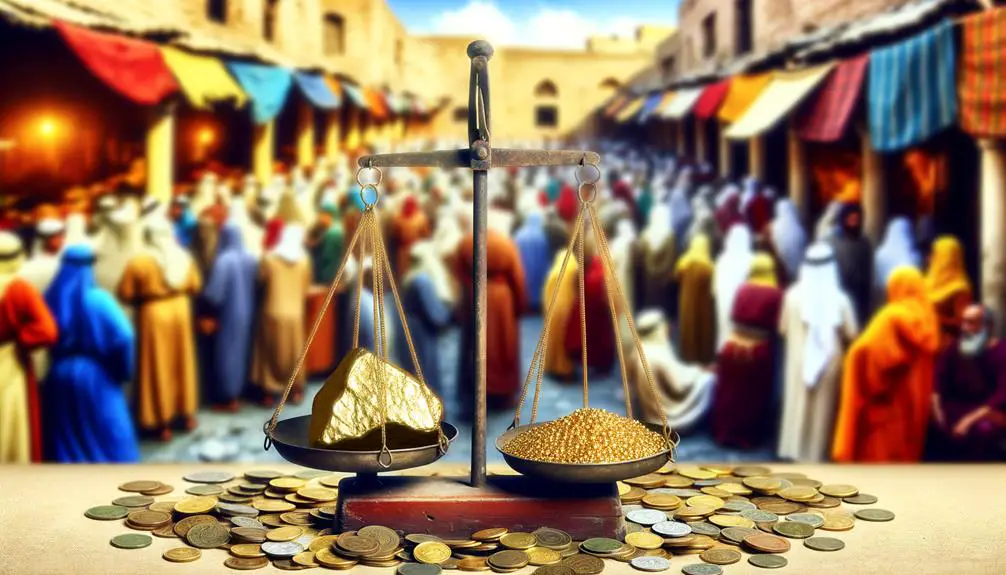
You must consider how a talent of gold's value influenced trade expansion and wealth distribution dynamics in ancient times.
The accumulation and control of such wealth could significantly alter economic landscapes, fostering trade routes and creating disparities in wealth.
Analyzing these impacts sheds light on the profound economic transformations driven by gold in historical contexts.
Trade Expansion Effects
The expansion of trade in ancient times significantly bolstered economic systems, facilitating unprecedented wealth accumulation and social evolution. Advancements in maritime navigation and the establishment of caravan routes opened up vast networks for trade, profoundly impacting economies across the globe.
- Maritime Navigation: Enabled the efficient transport of bulk goods, reducing costs and time.
- Caravan Routes: Facilitated the exchange of luxury goods and spices, enriching local markets.
- Economic Diversification: Regions specialized in certain commodities, fostering economic resilience.
- Technological Innovation: Trade necessitated improved transportation and financial systems.
- Cultural Exchange: Alongside goods, ideas and technologies spread, spurring innovation.
These factors collectively contributed to the dynamic growth and complexity of ancient economic systems, laying the groundwork for future economic development.
Wealth Distribution Dynamics
As trade expansion bolstered ancient economies, it simultaneously influenced wealth distribution dynamics, significantly affecting societal structures and individual prosperity.
This phenomenon catalyzed a pronounced shift in income inequality, with wealth accumulation becoming increasingly concentrated among the elite. You'll find that the mechanisms of trade not only facilitated the flow of goods but also entrenched the disparities between the affluent and the less fortunate.
This stratification led to a society where a small segment enjoyed the vast majority of resources, while the larger populace grappled with limited economic opportunities.
The impact of these dynamics extended beyond mere financial disparities, shaping social hierarchies, access to power, and even influencing cultural norms and practices. Understanding this aspect of ancient economies reveals the complex interplay between commerce, wealth, and societal evolution.
Scriptural References and Context

Scriptural references to a talent of gold, found across various books of the Bible, provide critical insights into its historical and cultural significance. These mentions aren't only pivotal for understanding the economic backdrop of ancient times but also for appreciating the symbolic weight gold carried in religious and societal contexts. As you delve into the scriptural passages, you'll encounter both measurement variations and translation discrepancies, which underscore the complexities of accurately gauging the value and significance of a talent of gold in biblical times.
To enhance your understanding, consider these specific points:
- Measurement variations across different biblical periods and regions lead to diverse interpretations of a talent's actual weight, affecting our understanding of its worth.
- Translation discrepancies further complicate matters, as the original Hebrew and Greek texts have been interpreted in various ways, leading to potential misrepresentations of the talent's true value.
- The talent's mention in the parable of the talents (Matthew 25:14-30) emphasizes its value as a metaphor for God-given gifts rather than just a monetary measurement.
- In Exodus 25:39, the construction of the Tabernacle involves an offering of talents of gold, highlighting its significance in worship and divine service.
- Kings and kingdoms, as described in historical accounts within the Bible, often amassed wealth quantified in talents of gold, reflecting the material's role in denoting power and prosperity.
Analyzing these scriptural references and contexts allows for a deeper appreciation of the multifaceted roles that a talent of gold played in biblical narratives, bridging historical, economic, and spiritual domains.
Comparing to Modern Wealth
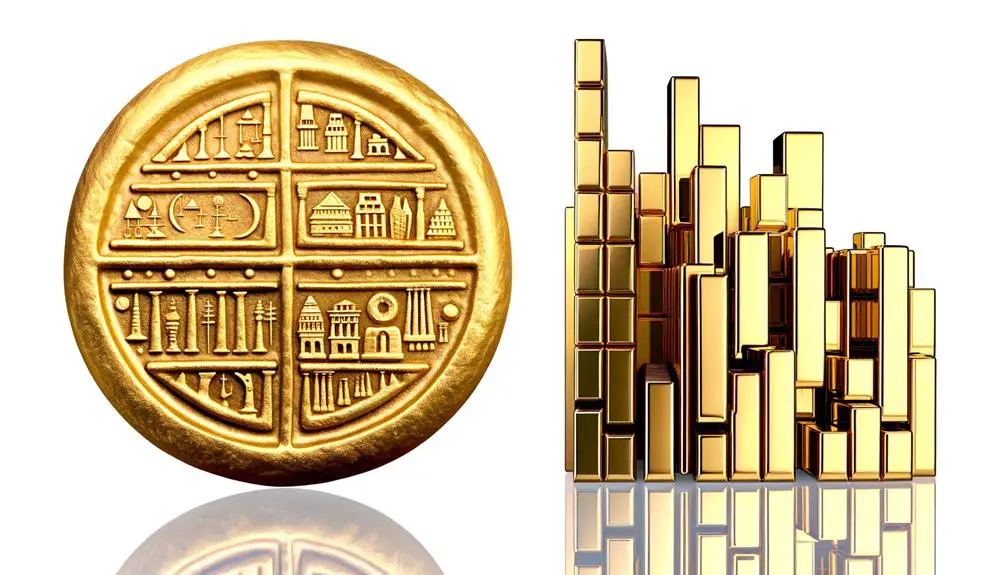
To understand the staggering worth of a biblical talent of gold in today's economy, it's essential to delve into current gold prices and historical wealth comparisons. A talent, as referenced in ancient texts, was approximately 75 pounds or 34 kilograms. Given the dynamic nature of gold prices, influenced by market demand, geopolitical stability, and economic factors, pinpointing an exact modern equivalent requires consideration of inflation adjustment and currency fluctuation.
Analyzing the value of a biblical talent in contemporary terms isn't straightforward. The price of gold per kilogram fluctuates, yet, by applying an average current price, one can approximate the value. However, this figure only brushes the surface. When you factor in inflation adjustment, the purchasing power of such a quantity of gold in ancient times often far exceeds its mere weight in gold today. Currency fluctuation further complicates this comparison, as the value of money changes relative to goods, services, and other currencies.
Aspect |
Detail |
|---|---|
Current Gold Price/kg |
Varies significantly |
Weight of a Talent |
Approximately 34 kg |
Inflation Adjustment |
Essential for accurate comparison |
Currency Fluctuation |
Adds complexity to value assessment |
This table encapsulates the complexity of translating ancient wealth into modern terms. It's not just about the gold's weight but understanding the economic context—past and present. In essence, a biblical talent of gold represented not just substantial material wealth but a symbol of immense purchasing power, far surpassing simple conversions to today's currency values.
Significance in Cultural Narratives
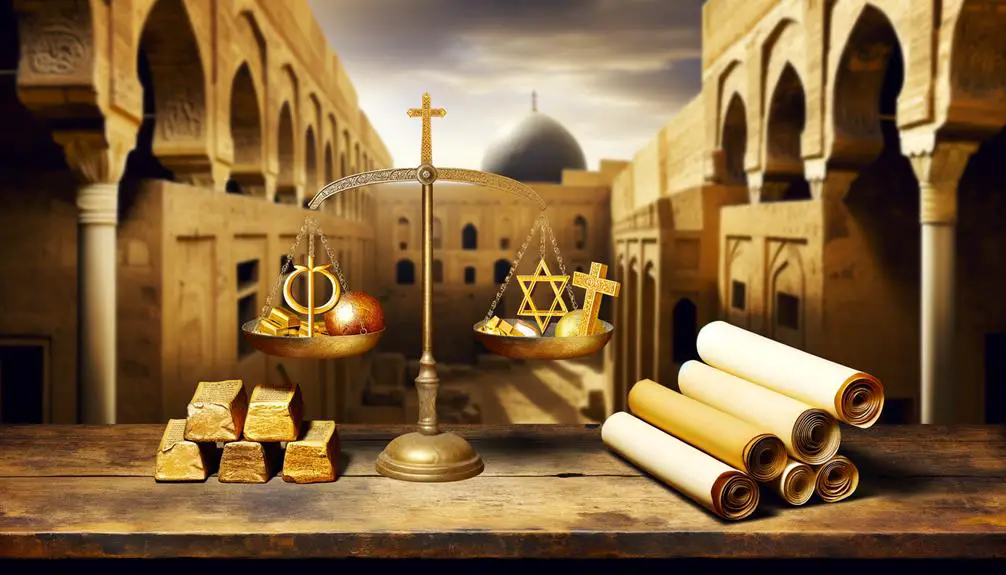
Understanding the economic implications of a talent of gold lays the groundwork for exploring its profound significance within cultural narratives. You'll find that throughout history, this measurement of wealth hasn't only symbolized prosperity and divine favor but has also been woven into the fabric of various mythological interpretations and artistic symbolism. The value and allure of gold have transcended mere monetary worth, embedding itself deeply in the collective human psyche and culture.
The significance of a talent of gold in cultural narratives can be analyzed through:
- Mythological interpretations: Many cultures have myths that revolve around the quest for gold, often imbued with moral lessons about greed, wisdom, and sacrifice. These stories reflect the human fascination with gold's perceived purity and eternalness.
- Artistic symbolism: In art, gold has been used to denote divinity, immortality, and purity. Its use in religious and royal iconography elevates subjects to a higher status, signifying their importance and reverence.
- Literary metaphors: Gold often symbolizes ultimate wealth, moral superiority, or a coveted object in literature, serving as a powerful metaphor for characters' desires and motivations.
- Historical narratives: The accumulation and loss of gold have been pivotal in historical narratives, shaping the fates of empires and civilizations. Its significance goes beyond wealth, symbolizing power, control, and the rise and fall of great powers.
- Social and cultural values: The pursuit and possession of gold have reflected and influenced societal values, including notions of success, prestige, and the human relationship with material wealth.
Through these lenses, you can appreciate the multifaceted role that a talent of gold plays in cultural narratives, transcending its economic value to embody deeper meanings and reflections on human nature and society.
Frequently Asked Questions
How Did the Concept of a Talent of Gold Vary Between Different Ancient Civilizations Beyond the Biblical Context?
You're exploring how different ancient civilizations valued a talent of gold, focusing on weight variations and cultural significance. Each society assigned its own weight to a talent, reflecting its economic and symbolic importance.
This variance shows not just a practical approach to trade and wealth but also highlights the deep cultural meanings gold held. Analyzing these differences, you'll uncover the rich mosaic of ancient values and the pivotal role gold played beyond mere currency.
What Modern Industries Could Be Significantly Impacted if a Talent of Gold Were Discovered Today?
Discovering a talent of gold today could significantly impact the jewelry and electronics industries, leading to an investment surge.
You'd see technology advancement as companies innovate to incorporate this windfall.
The finance sector would also feel the effects, potentially stabilizing or even lowering gold prices due to increased availability.
This could make gold more accessible for various uses, fostering new developments in sectors relying on this precious metal.
Are There Any Known Historical Figures Who Amassed Wealth Equivalent to Multiple Talents of Gold, and How Did They Utilize It?
Imagine walking through vast halls lined with gold, much like those owned by historical figures such as King Solomon or Mansa Musa. These legends amassed wealth comparable to mountains of gold talents, using it to build empires, foster alliances, and create enduring legacies.
Their financial prowess, when scrutinized for wealth comparison and historical accuracy, offers a fascinating lens into the utilization of extreme wealth in shaping civilizations and influencing global dynamics.
How Has the Symbolic Representation of a Talent of Gold Influenced Modern Literature and Film?
You've noticed the talent of gold's symbolic use in modern literature and film, haven't you? Its representation often serves as moral allegories, reflecting themes of greed, wealth, and human desire.
Cinematic adaptations, especially, leverage this imagery, enriching narratives with a timeless allure of gold. This symbolism, deeply rooted in ancient texts, provides a rich tapestry for analyzing characters' motivations and the consequences of their actions, offering nuanced insights into human nature.
What Are the Ethical Implications of Treasure Hunting for Biblical Talents of Gold in Contemporary Times?
You're navigating a complex landscape when considering the ethical implications of treasure hunting for biblical talents of gold today.
It's essential to weigh moral dilemmas inherent in such pursuits, including the potential disruption to historical sites.
Archaeological ethics must guide your actions, ensuring respect for cultural heritage and preventing exploitation.
This approach underscores the importance of scholarly rigor and precision in analyzing the consequences of these endeavors on both historical understanding and local communities.
Conclusion
In your journey through the annals of ancient economies, you've discovered that a talent of gold isn't just a weight but a beacon, illuminating the vast chasms between past and present wealth. Like a ship navigating treacherous waters, you've charted a course through historical measures, modern equivalents, and scriptural allegories, uncovering the profound impact of this golden measure on civilizations.
This exploration not only enriches your understanding but also bridges the gap between the tangible and the symbolic, crafting a narrative that transcends time.



Sign up